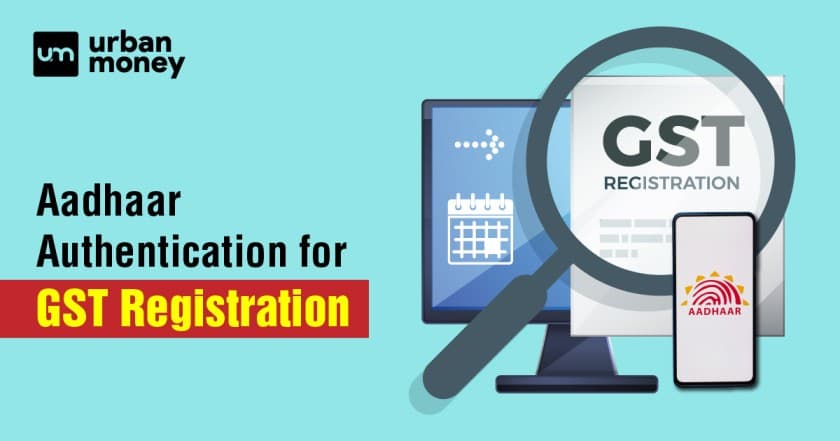- Home
- Adhaar Card
- Aadhaar Authentication In Gst Act
Aadhaar Authentication in GST Registration

- Personalized solutions
- Expert guidance
- Application assistance
- Credit score discussion
- Interest rate comparison


A notification was issued by the Central Board of Indirect Tax and Customs (CBIC) concerning Aadhaar Authentication in GST commencing from April 1, 2020. Under Section 25 (6C) of the CGST Act, some GST registration applicants must undergo Adhaar Authentication, barring some exemptions.
The authorities provide the option to authenticate your Aadhaar at the time of GST registration. This option of Aadhaar Authentication in GST registration was made available for applicants from August 21, 2020. However, this was a mandatory requirement for applicants registering under GST between April 1, 2020, to August 20, 2020, to obtain their GST registration. Some of the critical highlights of Aadhaar Authentication and a quick overview of the process are given below:
- The applicants who want to avail of this option must submit their Aadhaar number with their GST registration application.
- They are then required to e-verify the authentication link sent to their registered number or e-mail address on the GST portal. This process is concluded by mentioning the OTP sent on their e-mail or phone number in the portal.
- The Aadhaar authentication of the primary signatory would be sufficient in the case of companies/ LLPs/ AOP/ Societies/ Clubs/ Trust and such organisations.
- After authenticating Aadhaar with the GST, when the taxpayer files their returns on the GST portal, an OTP will be sent to their registered Aadhaar number. The applicant can proceed with filing returns after they mention the sent OTP.
What is Aadhaar Authentication?
The Aadhaar Authentication is the process of submitting of Aadhaar number along with the biometric details to the Central Identities Data Repository (CIDR) for verification. The CIDR verifies the authenticity of the details based on the information provided.
The process of Aadhaar Authentication was designed to authenticate the identity of an Aadhaar holder on an online platform. This results in a convenient and hassle-free validation procedure and assists in identifying any malpractices under the Goods and Services Tax Law.
Eligibility for Aadhaar Authentication
The Aadhaar authentication in GST registration is an optional process that an applicant can opt for, barring the individuals mentioned below:
- The proprietor of a Proprietorship firm.
- Any partner of a Partnership Firm.
- Karta of the Hindu Undivided Family.
- Managing Director or any full-time director of a company.
- Members holding positions in managing a community of AOP/ BOI/ Society.
- The trustee of a Trust.
Mandatory Cases of Aadhaar Authentication
The Aadhaar Authentication in GST registration has been made mandatory for the individuals mentioned below as per Section 25 (6C) of the CGST Act. Becoming eligible for GST registration for the following individual is a compulsory requirement.
Authorised Signatory of organisations such as
- Proprietorship Firm
- Partnership Firm
- Company
- AOP/BOI/Societies
- Trust
- Hindu Undivided Family
However, there are the following exceptions mentioned for Aadhaar Authentication in GST registration.
In case the concerned individual is not a Citizen of India.
In case they’re not the authorised signatories of organisations such as:
- Proprietorship Firm
- Partnership Firm
- Company
- AOP/BOI/Societies
- Trust
- Hindu Undivided Family
Cases of Deemed approval of GST Registration Application
The concerned officer is deemed to approve the application within a specific timeline concerning the nature of the case. A quick overview of the cases and timelines is given below:
Case 1: The individual has concluded their Aadhaar authentication process or is exempted from the requirement to authenticate their Aadhaar.
Timeline: 3 working days from the application submission date.
Case 2: The individual still needs to conclude their Aadhaar Authentication after opting for it.
Timeline: 21 days from the application submission date, the individual is required to send notice in Form REG-3
Case 3: The individual has not opted for Aadhaar Authentication in GST registration.
Timeline: 21 working days from the application submission date.
Case 4: The individual who has failed to complete the Aadhaar authentication process after opting for it. The concerned individual has replied in REG-4 to the notice issued in GST REG-3.
Timeline: 7 working days from the date of the recipient of the response.
Steps for Aadhaar Authentication in GST Registration
The authorised signatory, promoters/ partner, or the concerned individual must follow the steps mentioned below for Aadhaar Authentication in GST registration.
STEP 1: Visit the www.gst.gov.in portal.
STEP 2: The applicant should navigate to Services after visiting the homepage. Select the registration option and then click on the new registration.
STEP 3: Follow the procedure of GST registration. The individual can opt for Aadhaar Authentication by selecting the Aadhaar Authentication Tab.
STEP 4: The applicant is required to choose whether they want to authenticate their Aadhaar or not as per their discretion. They can either select ‘Yes’ or ‘No’.
STEP 5: Aadhaar Authentication link will be sent to the registered mobile number or e-mail ID of the promoter/ partner or authorised signatory. In case the applicant selects ‘Yes’,.
- After clicking on the link, the applicant must mention their Aadhaar Number and authenticate it by clicking on ‘validate’.
- The details provided in the registration form and UIDAI will be cross-checked. The authorised signatory will receive an OTP on their registered mobile number and e-mail.
- The applicant is required to mention the OTP received in the box present at the validation screen. You’ll receive a confirmation message after.
In case the applicant selects ‘No’ for the Aadhaar Authentication in GST registration.
- The application shall be sent to the Jurisdictional Tax Authority.
- They will oversee the documental and physical verification before granting their approval.
Steps for Aadhaar Authentication for Existing Taxpayers
The existing Taxpayers can authenticate their Aadhaar by implementing the following steps:
STEP 1: Visit the GST portal. Go to the “My profile” page. Select the Aadhaar Authentication Status. You’ll be presented with two options.
STEP 2: Choose from the two options provided that are-
- Send Aadhaar Authentication
- Upload e-KYC documents.
- If the applicant selects the ‘Send Aadhaar Authentication Link’ option, look for the links received on the registered mobile number and e-mail address to conclude the OTP verification process.
- If the applicant selects the ‘Upload e-KYC’ documents option, the tax officer approves or rejects the documents. It is to be noted that the applicant would be regarded as e-KYC authenticated, not Aadhaar authenticated.
Frequently Asked Questions (FAQs)
How to complete Aadhaar authentication in GST registration?
An applicant can authenticate their Aadhaar in the GST registration by opting for the Aadhaar Link option while filling the Form-B of the application and following the given steps:
- An authentication link would be sent to the registered mobile number.
- Mention the Aadhaar Number and Validate the sent link.
- The applicant will receive an OTP, which they must mention to conclude the process.
- The applicant will receive a confirmation message after 15 days.
How long does the Aadhaar authentication Link work in the GST portal?
The Aadhaar Authentication link generated is valid for 15 days only.
Is Aadhaar Authentication mandatory for GST registration?
The Aadhaar Authentication in GST registration has been made mandatory for the following authorised signatories.
- The proprietor of a Proprietorship firm.
- Any partner of a Partnership Firm.
- Karta of the Hindu Undivided Family.
- Managing Director or any full-time director of a company.
- Members holding positions in managing a community of AOP/ BOI/ Society.
- The trustee of a Trust.
Is physical verification mandatory for GST registration?
The GST council secretariat made the physical verification of business premises a compulsion for GST registration. This is done to curb the issuance of fraudulent GST invoices.